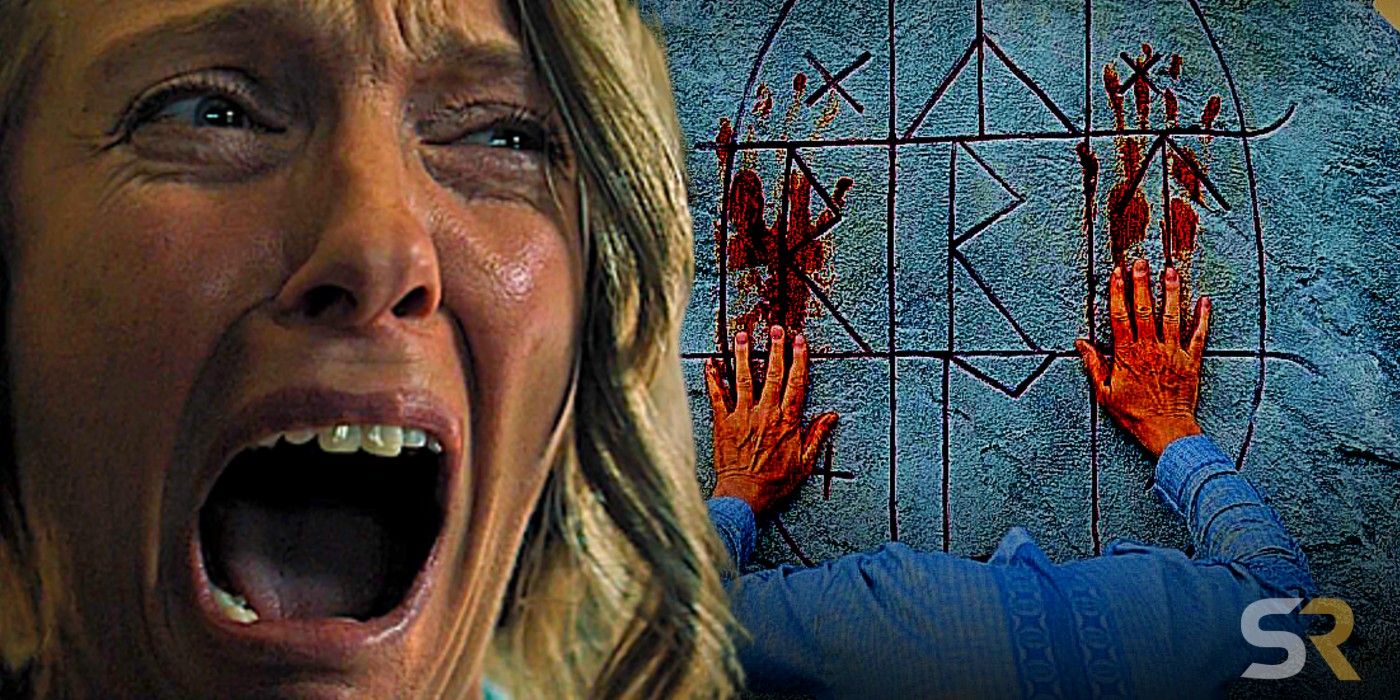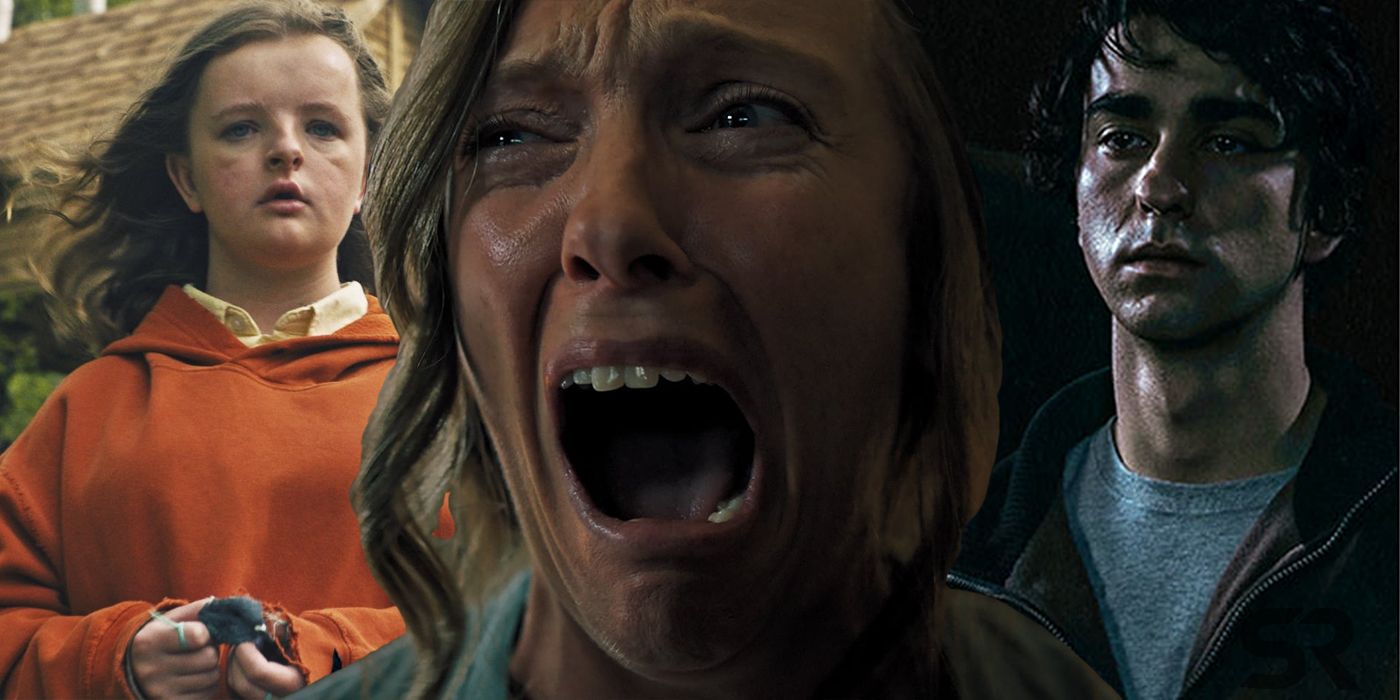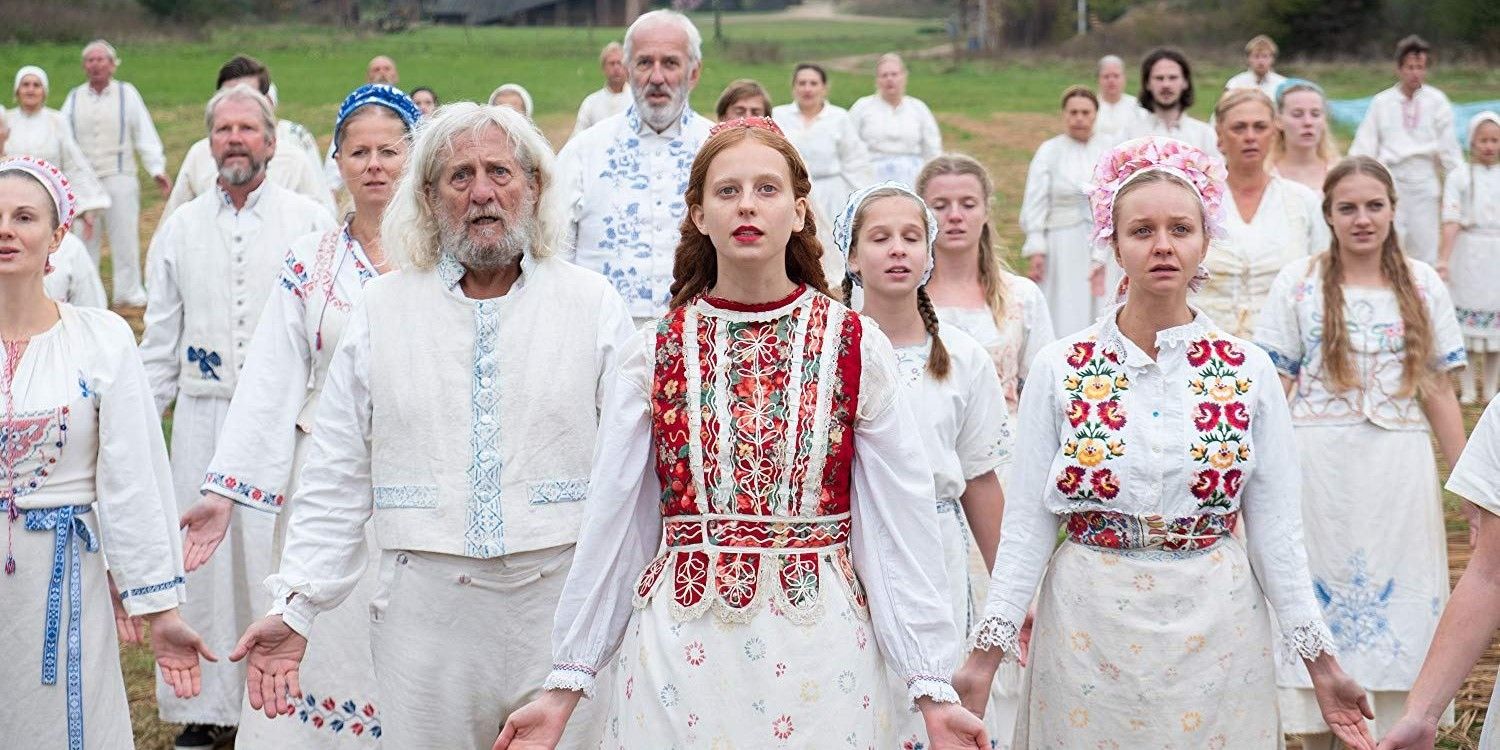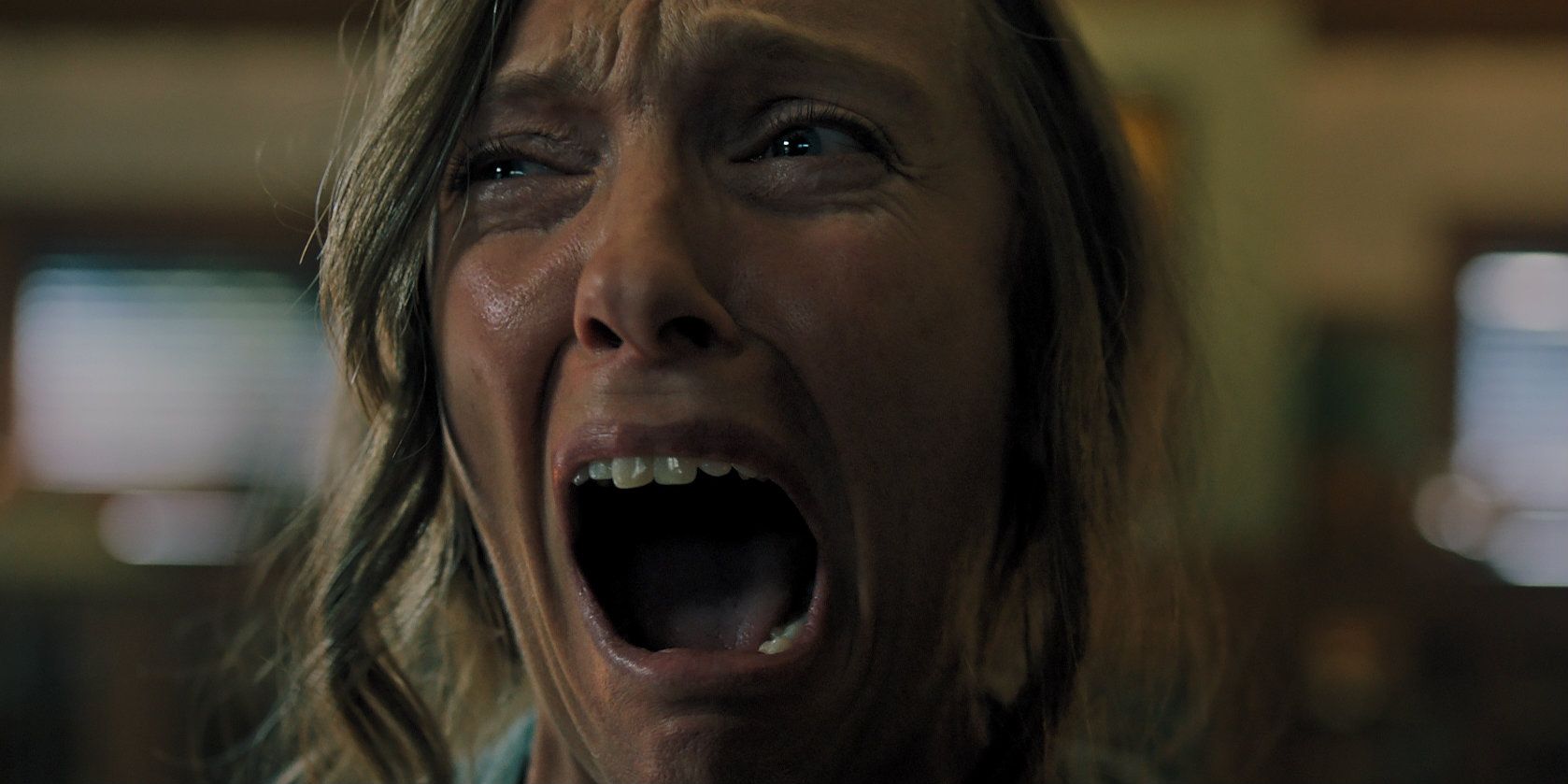WARNING: Spoilers ahead for Midsommar and Hereditary
How does Midsommar compare to Hereditary? The two A24 films from the same creator share thematic links yet build suspense in entirely different ways. In both Midsommar and Hereditary, writer/director Ari Aster utilizes traditional horror techniques to trigger the audience, all the while using the settings and visual aesthetics for sub-commentaries about internalized fear.
Released in 2018, Hereditary examines how a family copes with death and psychological trauma. Toni Collette stars as Annie, the surviving matriarch of the Graham family. She loses her daughter Charlie (Milly Shapiro) in a tragic car accident and struggles to maintain healthy relationships with her husband Steve (Gabriel Byrne) and son Peter (Alex Wolff). Hereditary balances real-life character drama with supernatural threats, culminating in a shocking final sequence that ends with Charlie’s resurrection as King Paimon, who uses Peter’s body for a male host. In Aster’s 2019 film Midsommar, Florence Pugh stars as Dani, a college student who travels to Sweden with her boyfriend and his friends after a murder-suicide that left her sister and parents dead. Through a bizarre sequence of events, Dani confronts her fears and finds her place in the world as the Midsommar May Queen.
Hereditary and Midsommar are both polarizing films that allow for different interpretations. Here’s how the various themes and filmmaking techniques compare and contrast.
The Similarities Between Hereditary & Midsommar
Aster grounds both films with a cult-community premise. Hereditary builds to a final act revelation about the Graham family legacy, whereas Midsommar’s focal Swedish community steadily communicates the specifics of their longstanding rituals. The Grahams struggle with the unknown at home during Hereditary, while Dani and company get psychologically lost in Midsommar's Scandinavian setting.
Both Hereditary and Midsommar conclude with social outcasts being anointed as “The Chosen One.” Young Charlie Graham makes clucking noises and becomes fascinated with death. During a party sequence in Hereditary, she struggles with an allergic reaction and literally loses her head on the way to a hospital. The death sequence marks Hereditary’s inciting incident and correlates with the bloody final act, in which Charlie is crowned as King Paimon. For Midsommar, Aster similarly uses a party scene to underline Dani’s discomfort. She then travels to a foreign land with a group of self-interested males. In Sweden, Dani finds a new family by accepting her reality. Hereditary and Midsommar end with dramatic coronation ceremonies and retribution for non-believers.
Familial trauma represents the connective narrative tissue in both Hereditary and Midsommar. Annie loses her elderly mother AND her young daughter. Incidentally, she’s noticeably off-balance, struggling to cope with the past and present. Hereditary is blatant with its familial themes, evidenced by the title itself. Likewise, Midsommar is fundamentally about coping with familial trauma, as Dani essentially deals with survivor’s guilt all by herself. The big twist is that Midsommar’s Swedish community grieves together, literally and figuratively. They ultimately share Dani’s pain and welcome her into their family. Midsommar ends with Dani choosing family over a diseased romance.
Aster uses tragedy as the narrative foundation in both films, so gory memories become especially important for the character arcs. In Hereditary, Charlie’s decapitated head lingers in Peter’s mind. The same applies to Annie, who discovers said head in the family driveway. Later, a possessed Annie severs her own head. In Midsommar, Aster once again uses aggressive gore to complement themes associated with grief and familial trauma. Two elder characters commit ritual suicide at the age of 72, the end of their seasonal life cycle. Aster uses close-up visuals to show literal head trauma, as a woman’s skull is crushed upon impact while a male’s face is smashed by fellow community members as an act of mercy. Hereditary and Midsommar use aggressive gore as a double-edged narrative sword, with head trauma - literal and psychological - being the underlying theme.
The Differences & Contrasts Between Hereditary & Midsommar
Hereditary explores how a family internalizes grief, while Midsommar details how a community shares various emotions, including grief. The Graham family is united by blood in Hereditary but separated by resentment. Annie figuratively carries a huge burden; her shoulders are filled with stress. Meanwhile, Steve is utterly detached, unable to connect with his wife or son. As for Peter, he’s emotionally traumatized by Charlie’s death, and completely unaware that he’s being manipulated and prepped by a cult. This explains Peter’s distinct cry; a recurring motif that adds an extra layer of unease.
In Midsommar, the entire Swedish commune of Hårga shares pain. They moan together when one of the elders survives a suicide ritual, and they cry together when Dani wails upon discovering her boyfriend having sex with a young girl. Peter cries in Hereditary because he’s so completely alone and confused. Dani cries in Midsommar, only to learn that she’s not alone.
Location is key for both films. Hereditary features domestic horror with a supernatural twist. In contrast, Midsommar’s horror is foreign - from the protagonist's POV - and boosted by the human element. Aster contrasts familiar concepts with the unknown; characters are forced to process internalized grief while re-assessing what they supposedly know to be true. In Hereditary, a male loses his agency by the final sequence. But in Midsommar, a female takes control and decides the fate of others (which theoretically also happens in Hereditary). As for the cult/community members, Aster spaces them out in wide shots, with Midsommar being significantly more expansive because of the outdoor Swedish setting. In Hereditary, the cult member spacing is contained to the domestic setting, thus creating a sense of claustrophobia, especially during the final sequence in Charlie’s treehouse.
Character design separates Aster’s two features. Hereditary features accessible archetypes; characters who can be quickly be associated with specific concepts: The Grieving Mother (Annie), The Detached Father (Steve), The Outsider (Charlie), The Awkward Teenager (Peter). To be fair, Hereditary’s characters are indeed complex; they are not defined by one attribute. In terms of storytelling, however, familiar archetypes hold the film together and keep the audience engaged. In contrast, Midsommar’s characters are less accessible. Here, The Other is an entire community; one can’t quite be sure about their motivations.
As for the main group of travelers, Aster makes Dani and Christian (Jack Reynor) the prototypical young couple; characters with relatable problems, at least on the surface. Their complexities are revealed by their companions and host, all of whom can’t be easily categorized, specifically Josh (William Jackson Harper) and Pelle (Vilhelm Blomgren). In an '80s horror film, Josh might be The Token Black Guy, a character associated with cultural cliches. But in Midsommar, Josh is his own man, a black American in Sweden trying to move forward with his thesis research. Meanwhile, Pelle is gentle and kind on the surface, but his endgame is unclear, at least during the majority of the film.
In comparison to Hereditary, Midsommar’s sound design and jump cuts are more subtle. Aster’s 2018 film includes a synth-heavy musical motif to underline the inherent dread, whereas the Sweden-based film uses an acapella vocal in the opening moments, one that plays over later scenes as well. In short, Midsommar’s sound design - singing and moaning - is more organic throughout. In addition, at least two jump cuts seamlessly transport characters from one location to another, with their posture remaining the same. When the main characters arrive in Sweden, the image is even flipped upside down. Aster's visual design plays into the characters’ perception of reality, and suggests that the concept “Out of Sight, Out of Mind” doesn’t necessarily apply during moments of intense grief.
Why Hereditary Is The Better Movie
Hereditary operates more efficiently than Midsommar; it’s structured for mainstream success. Given the family-themed storyline, Hereditary is fundamentally relatable, even if the central figures aren’t representative of various demographics. As a whole, the film taps into traditional genre tropes and maintains a steady pace. Plus, Hereditary's most shocking moments subvert expectations: Aster kills off someone who appears to be a main character (Charlie), and subsequently uses her severed head as a plot device. Hereditary progressively builds towards its unnerving conclusion, one that provides closure and clear answers. As a first-time viewing experience, Hereditary is the better movie.
That’s not to say that Midsommar is deeply flawed or cryptic with its conclusion. The pacing could throw some viewers off, while others may appreciate the slow burn; the sense of increasing dread. Midsommar doesn’t feel like a long movie whatsoever, but the opening does indeed drag with its exposition and heavy subject matter. Whereas Hereditary waits a bit to show dead bodies, Midsommar shows corpses within minutes. This establishes Dani’s trauma, and the fact that she has little time to process the tragedy before leaving for Sweden.
Unsurprisingly, Midsommar's first act mise-en-scène includes noticeable easter eggs, specifically a painting - featuring a crowned woman with a bear - that hangs over Dani while she sleeps. Of course, Midsommar ends with Dani’s coronation and her boyfriend’s fiery bear-skin death. So, Aster essentially invites various interpretations by foreshadowing specific images. Overall, Midsommar is a fantastic film, one that’s worthy of repeat viewings, but it's geared more towards cinephiles than casual moviegoers.
One could argue that Midsommar successfully builds upon themes that Aster introduces in Hereditary. Because there are so many thematic links, however, Midsommar feels less original than Hereditary. It’s almost like Aster used Hereditary’s success to design a safe template for Midsommar, to avoid a so-called "sophomore slump" and to please both the mainstream and art-house crowds. Still, it’s a strong second feature from a seasoned filmmaker with a unique cinematic voice.




